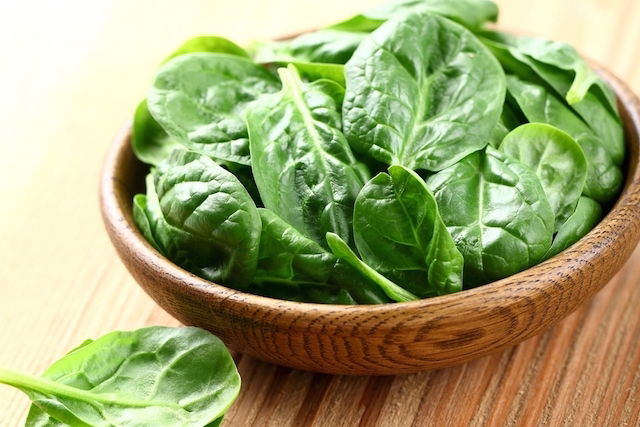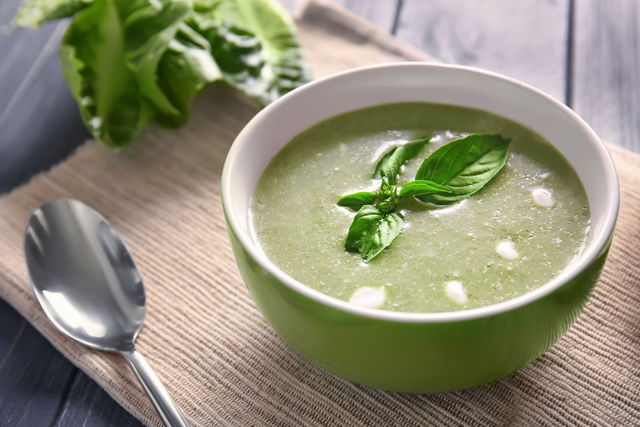The benefits of spinach are derived from its high vitamin A, vitamin C and vitamin E contents as well as its phenolic compounds such as lutein, zeaxanthin and kaempferol. These contains antioxidant and anti-inflammatory properties, which help fight premature skin aging and prevent the development of cardiovascular diseases. Spinach also contains minerals such as potassium and calcium, which are necessary for regulating blood pressure, and iron, an essential mineral to help treat and prevent anemia.
This dark green vegetable is very versatile and can be eaten raw or cooked in salads, soups, stews and natural juices. It is an easy, inexpensive and low-calorie option for enriching your diet with vitamins and minerals. To get the benefits of spinach, you should consume about 90 g, 5 times a week, which is equivalent to about 3.5 tablespoons of this cooked vegetable.
Spinach should ideally be consumed with main meals, as it is best absorbed in the body when consumed with natural fats, like those found in meat and vegetable oils.

Health benefits
The main benefits of spinach are:
1. Improving eye health
Spinach is rich in antioxidants such as lutein and zeaxanthin, which work by fighting free radicals that can cause damage to eye cells. Therefore, this leafy green can help to improve vision and eye health.
In addition, spinach has large amounts of beta-carotene and vitamin A, which are important for keeping eye cell membranes healthy and prevent vision problems such as dry eyes, night blindness or age-related macular degeneration.
2. Preventing anemia
Spinach helps prevent anemia because it is rich in iron, a mineral that is essential for the formation of hemoglobin. Hemoglobin is a protein present in red blood cells and is responsible for transporting oxygen to all parts of the body.
Spinach also has folic acid in its composition, which is also necessary for the formation of healthy red blood cells and keeping them within healthy levels.
To increase the absorption of iron from spinach, you should eat a citrus fruit as a dessert after an iron-filled meal, such as orange, tangerine, pineapple or kiwi. Check out other iron-rich foods that you can include in your die.
3. Regulating blood pressure
Spinach contains large amounts of nitrates and potassium, which are substances that trigger the relaxation of blood vessels. This allows blood to circulate more easily and lowers blood pressure, which can be very useful for hypertensive patients.
In addition, the magnesium present in spinach acts as a natural calcium channel blocker, inhibiting the release of a neurotransmitter, norepinephrine. This neurotransmitter is responsible for increasing blood pressure, and inhibiting it can therefore helps to reduce it.
4. Protecting against cardiovascular diseases
The vitamin C, lutein and polyphenolic compounds (such as quercetin and kaempferol) present in spinach have a powerful antioxidant action. They help to reduce the damage caused by oxidative stress in blood vessel cells which can lead to thickening of the artery walls. Spinach therefore helps to prevent and reduce the risk of cardiovascular diseases such as atherosclerosis, heart attacks and strokes.
5. Keeping bones healthy
Spinach is rich in calcium, magnesium and phosphorus which are minerals that are fundamental for strengthening, increasing resistance and maintaining healthy bones. It can help prevent diseases such as osteoporosis, osteopenia or rickets, for example.
6. Promoting weight loss
Spinach is low in calories. Each 100 g of raw or cooked leaves has approximately 23 calories, which is why it is a great addition to weight loss diets. In addition, it contains fiber which keeps you full and reduces hunger.
7. Regulating blood sugar levels
Some laboratory and animal studies show that the thylakoids present in spinach can increase insulin sensitivity and reduce blood sugar levels by inhibiting the activity of enzymes involved in the carbohydrate digestion process. Spinach could therefore be an important ally in the treatment of diabetes.
However, human studies are still needed to prove this benefit.
8. Maintaining brain health
Spinach is rich in anti-inflammatories and antioxidants such as vitamin E and lutein, which prevent damage to neurons. It can keep the brain healthy, and protect it from age-related neurodegenerative diseases such as Alzheimer's disease.
9. Strengthening the immune system
Spinach is rich in nutrients such as vitamins A and C, which help strengthen the immune system. It improves the response of defense cells, which is essential for preventing and fighting infections.
10. Improving skin appearance
Because it is rich in antioxidants like beta-carotene, vitamin A, C and E, spinach can help to fight the free radicals that cause skin aging.
The vitamin C in spinach also stimulates the skin's production of collagen, reducing sagging and the appearance of wrinkles and expression lines. The vitamin A in this leafy green protects the skin from damage caused by the sun's ultraviolet rays.
11. Helping to fight cancer
Some laboratory studies using cervical cancer cells show that the glycolipids in spinach can destroy or at least help slow down the multiplication of cancer cells.
In addition, the polyphenols present in spinach, such as lutein and kaempferol, have a powerful antioxidant action, and have also been shown to help inhibit the growth of breast, colon, oesophageal, prostate and liver cancer cells and cause the destruction of these cells.
However, human studies are still needed to prove these benefits.
Nutritional information
The following table outlines the nutritional information in 100 g of of raw and sauteed spinach.
It is important to note that in order to obtain all the benefits of spinach mentioned above, it should be incorporated into a balanced and healthy diet.
Healthy recipes
Spinach can be eaten raw, as long as it is properly washed. It can also be cooked or sauteed and added to recipes. Some spinach recipes that are quick, easy to prepare and nutritious are:
1. Cream of spinach

Ingredients
- 1 bunch of washed spinach
- 1 cup skim milk
- 2 tablespoons olive oil
- 2 tablespoons whole wheat flour
- 3 tablespoons of light grated cheese
- Grated nutmeg to taste
- Salt and ground pepper to taste
Directions
Place the spinach in a pan with a little salt and cook over a low heat. Drain the water that forms and then chop the spinach. In another pan, add the olive oil, chopped spinach and whole wheat flour. Gradually add the milk, stirring well. If desired, add nutmeg and black pepper for seasoning. Add the grated cheese and mix well for a few more minutes. Turn off the heat and serve. This recipe serves 4 people.
2. Oven-baked spinach dumplings

Ingredients
- 1 bunch of washed spinach
- 2 whole eggs
- 1 small chopped onion
- 2 tablespoons of olive oil
- 2 crushed garlic cloves
- 2 cups skim milk
- 2 tablespoons of low-fat grated cheese
- 2 cups whole wheat flour
- 1 tablespoon baking powder
- Black pepper
- Salt to taste
Directions
Cook the spinach over low heat with a little salt. Remove the water that forms and chop or titrate the spinach. In another pan, add the olive oil and sauté the chopped onion, the crushed garlic and the cooked spinach. Turn off and leave to cool. Beat the eggs and add to the pan with the spinach. Gradually add the milk, stirring well, and add salt as desired.
Add the parmesan cheese, whole wheat flour and baking powder. If desired, add a pinch of black pepper. Form balls with your hands or two spoons and place them on a tray lined with aluminum foil or parchment paper. Another option is to place them in over pans greased with a little olive oil. Bake in a preheated oven at 180ºC for 25 to 30 minutes. Serve afterwards. This recipe yields 10 to 12 dumplings.
3. Spinach soufflé

Ingredients
- ½ bunch of washed spinach
- 1 tablespoon whole wheat flour
- ½ cup warm skim milk
- 2 egg whites beaten until fluffy
- 2 egg yolks
- ½ tablespoon lightly grated cheese
- Olive oil for greasing
- Salt to taste
Directions
Add the spinach to a pan. Sauté and drain the water that forms. In another pan, add the milk and gradually add the whole wheat flour, stirring well until the mixture thickens. Leave to cool and add the egg yolks, Parmesan cheese, sauteed spinach and egg whites. Pour the mixture into a baking dish greased with olive oil and bake in a preheated oven at 180ºC for approximately 40 minutes. Serve afterwards. This recipe serves 4 people.
